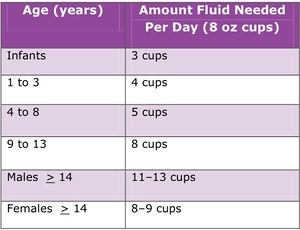Dehydration
Original Editors - Jordan Dellamano Daniel McCoy from Bellarmine University's Pathophysiology of Complex Patient Problems project.
Top Contributors - Lydia Marie Coots, Jordan Dellamano, Daniel McCoy, Courtney Campbell, Elaine Lonnemann, Kim Jackson, Vidya Acharya, Lucinda hampton, Scott Buxton, Admin, 127.0.0.1, Rachael Lowe, Tony Lowe, Wendy Walker and WikiSysop
Introduction[edit | edit source]
Dehydration occurs when the body loses more fluid than it takes in. This condition can result from illness; a hot,dry climate; prolonged exposure to sun or high temperatures; not drinking enough water; and overuse of diuretics or other medications that increase urination. Dehydration can upset the delicate fluid-salt balance needed to maintain healthy cells and tissues.
- Water accounts for about 60% of a man's body weight. It represents about 50% of a woman's weight.
- Young andmiddle-aged adults who drink when they're thirsty do not generally have to do anything more to maintain theirbody's fluid balance.
- Children need more water because they expend more energy, but most children who drinkwhen they are thirsty get as much water as their systems require.
- Age and dehydration: Adults over the age of 60 who drink only when they are thirsty probably get only about 90% of the fluid they need.
- Dehydration in children usually results from losing large amounts of fluid and not drinking enough water to replacethe loss. This condition generally occurs in children who have stomach flu characterized by vomiting and diarrhoea, or who can not or will not take enough fluids to compensate for excessive losses associated with feverand sweating of acute illness.
- An infant can become dehydrated only hours after becoming ill. Dehydration is amajor cause of infant illness and death throughout the world.[1]
There are three main types of dehydration: hypotonic (primarily a loss of electrolytes), hypertonic (primarily loss of water), and isotonic (equal loss of water and electrolytes). The most commonly seen in humans is isotonic. [2]
Etiology[edit | edit source]
Body water is lost through the skin, lungs, kidneys, and GI tract. The loss of body water without sodium causes dehydration.
- Water is lost from the skin, lungs, gastrointestinal tract, and kidneys.
- Dehydration results when water losses from the body exceed water replacement.
- It may be caused by failure to replace obligate water losses.
There are several forms of dehydration.
- Isotonic water loss occurs when water and sodium are lost together. Causes of isotonic water loss are vomiting, diarrhea, sweating, burns, intrinsic kidney disease, hyperglycemia, and hypoaldosteronism.
- Hypertonic dehydration occurs when water losses exceed sodium losses. Serum sodium and osmolality will always be elevated in hypertonic dehydration. Excess pure water loss occurs through the skin, lungs, and kidneys. Etiologies are fever, increased respiration, and diabetes insipidus.
- Hypotonic dehydration is mostly caused by diuretics, which cause more sodium loss than water loss. Hypotonic dehydration is characterized by low sodium and osmolality.
The source of water loss relates to the etiologies of dehydration:
- Failure to replace water loss: altered mentation, immobility, impaired thirst mechanism, drug overdose leading to coma
- Excess water loss from the skin: heat, exercise, burns, severe skin diseases
- Excess water loss from the kidney: medications such as diuretics, acute and chronic renal disease, post-obstructive diuresis, salt-wasting tubular disease, Addison disease, hypoaldosteronism, hyperglycemia
- Excess water loss from the GI tract: vomiting, diarrhea, laxatives, gastric suctioning, fistulas
- Intraabdominal losses: pancreatitis, new ascites, peritonitis
- Excess insensible loss: sepsis, medications, hyperthyroidism, asthma, chronic obstructive pulmonary disease (COPD), drugs[3]
Prevalence[edit | edit source]
- Healthy adults with access to water rarely become dehydrated.
- Any adult may develop dehydration as a complication of an illness such as hyperglycemia.
- Data shows that older adults are more likely to develop dehydration. The elderly population is also 20% to 30% more prone to developing dehydration due to immobility, impaired thirst mechanism, diabetes, renal disease, and falls.[4]
Characteristics/Clinical Presentation[edit | edit source]
Increased thirst, dry mouth, light-headedness, fatigue, impaired mental focus, low urine output, dry skin, inability to produce tears, sunken eyes are the signs of dehydration. [5]
| Mild Dehydration |
Moderate Dehydration |
Severe Dehydration |
|
|
|
Increased tiredness, headaches, nausea, and paresthesias are experienced at about 5% to 6% water loss. With 10% to 15% fluid loss, may experience symptoms of muscle cramping, dry and wrinkly skin, beginning of delirium, painful and/or decreased urine output, and decline in eyesight. Losses of water greater than 15% are usually fatal[7].
When to seek medical attention[edit | edit source]
- Constant or increased vomiting for greater than a 24 hour period
- Diarrhoea greater than two days
- Fever over 101o degrees
- Decreased urine production
- Weakness
- Confusion[8]
Diagnostic Tests[edit | edit source]
Both physical and mental exams help to diagnose dehydration.
- A patient presenting symptoms such as disorientation, low blood pressure, rapid heartbeat, fever, lack of sweat, and inelastic skin will usually be considered dehydrated.
- Blood tests are often employed to test kidney function and to check sodium, potassium, and other electrolyte levels (chemicals that regulate hydration in the body and are crucial for nerve and muscle function). A urine analysis will provide very useful information to help diagnose dehydration. In a dehydrated person, urine will be darker in color and more concentrated.
- To diagnose dehydration in infants, doctors usually check for a sunken soft spot on the skull. They may also look for a loss of sweat and certain muscle tone characteristics.[2]
Complications[edit | edit source]
If dehydration is not checked, it can lead to serious complications; these can include:
- Low blood volume – less blood produces a drop in blood pressure and a reduction in the amount of oxygen reaching tissues; this can be life threatening.
- Seizures – due to an imbalance of electrolytes.
- Kidney problems – including kidney stones, urinary tract infections, and eventually kidney failure.
- Heat injury – ranging from mild cramps to heat exhaustion or even heat stroke[9].
Differential Diagnosis [edit | edit source]
- The principle differential of dehydration in adults is the loss of body water versus the loss of blood.
- This is important because blood loss should be replaced with blood, while water loss should be replaced with fluid.
- The next point to consider is the differential diagnosis of the cause of dehydration (see Etiology above)[3]
Treatment[edit | edit source]
Dehydration must be treated by replenishing the fluid level in the body. This can be done by consuming clear fluids such as water, clear broths, frozen water or ice pops, or sports drinks (such as Gatorade). Some dehydration patients, however, will require intravenous fluids in order to rehydrate. People who are dehydrated should avoid drinks containing caffeine such as coffee, tea, and sodas.
Underlying conditions that are causing dehydration should also be treated with the appropriate medication. This may include medication available to purchase over-the-counter or online, such as anti-diarrhea medicines, anti-emetics, and anti-fever medicines.[2]
Physical Therapy Management & Prevention [edit | edit source]
There is no direct physical therapy intervention for dehydration in the severe category; however, prevention and fluid replacement orally is something physical therapists can influence through patient education.
Patients should be educated about the signs and symptoms of dehydration in order to know when they may need to seek help. This is done by proper knowledge of hydration[10].
Environmental Factors[10][edit | edit source]
Heat [11]
- Being outside on a hot or humid day can cause your body to need more fluids
- It is recommended by the American Heart Association to drink water before being outdoors in the heat. This way you do not have to play catch up with Hydration when strain has already been placed on the heart.
Cold [12]
- Fluid intake also needs to be increased in cooler environments.
- Cool temperatures may blunt thirst
- Inhalation of cold, dry air increases warmth and moisture in the lungs which causes water vapor to be exhaled
- Physical Activity in the cold can increase respiratory water losses by 15-45 mL per hour
- Insulated clothing can also increase perspiration, increasing water loss
Hydration and Exercise
Before exercise: Drink 12-20oz of fluid 2 hours leading up to exercise
During Exercise:
- <1-hour drink 16-30 oz of water
- 1-3 hours drink 16-30 oz 6-8% CHO, sodium drink per hour of exercise
- >3 hours similar to guidelines for 1-3 hours but increase sodium intake
Avoid caffeine or alcohol in beverages due to their diuretic effects
Avoid hyponatremia which can occur by drinking too much fluid. therefore, diluting sodium
Monitor dehydration with changes in body weight and urine color. Each pound lost during exercise, drink 15-16oz of fluid [13]
Resources[edit | edit source]
References[edit | edit source]
- ↑ The free dictionary Dehydration Available: https://medical-dictionary.thefreedictionary.com/dehydration (accessed 12.7.2021)
- ↑ 2.0 2.1 2.2 Dehydration-What is Dehydration?. News-medical website. Available at: http://www.news-medical.net/health/Dehydration-What-is-Dehydration.aspx. Accessed on March 30, 2017.
- ↑ 3.0 3.1 Taylor K, Jones EB. Adult Dehydration. InStatPearls [Internet] 2020 Mar 24. StatPearls Publishing.Available from:https://www.statpearls.com/articlelibrary/viewarticle/37754/ (last accessed 18.11.2020)
- ↑ Taylor K, Jones EB. Adult Dehydration. [Updated 2021 May 19]. In: StatPearls [Internet]. Treasure Island (FL): StatPearls Publishing; 2021 Jan Available: https://www.ncbi.nlm.nih.gov/books/NBK555956/ (accessed 12.7.2021)
- ↑ http://survivalscoop.blogspot.com/2010/08/signs-of-dehydration-why-you-need-water.html
- ↑ 6.0 6.1 6.2 6.3 6.4 Goodman, C., & Snyder, T. (2013). Differential diagnosis for physical therapists: Screening for referral. (5th edition ed., pp. 171). St. Louis, MO: Saunders.
- ↑ Dehydration: Why is it so dangerous? Rehydrate website. 2012. Available at: rehydrate.org/dehydration/index.html (Accessed April 3, 2017)
- ↑ Dehydration-Home Treatment. WebMD Website. Available at http://www.webmd.com/fitness-exercise/tc/dehydration-home-treatment#1 (2015)Accesed March 30,2017.
- ↑ Medical News Today Dehydration Available: https://www.medicalnewstoday.com/articles/153363#complications (accessed 12.7.2021)
- ↑ 10.0 10.1 Center for Disease Control. Dengue Clinical Case Management E-learning: Hydration Status. https://www.cdc.gov/dengue/training/cme/ccm/Hydration%20Status_F.pdf (assessed 3 April 2017)
- ↑ 20. American Heart Association. Staying Hydrated-Staying Healthy. (2014) Available at http://www.heart.org/HEARTORG/HealthyLiving/PhysicalActivity/FitnessBasics/Staying-Hydrated---Staying-Healthy_UCM_441180_Article.jsp#.WOWKD5H3ahA Accessed on March 30, 2017
- ↑ Quaglio L. The Dehydration Equation. American Fitness. Winter2017. Available from: SPORTDiscuss with Full Text. Accessed on March 30,2017.
- ↑ Pariser G. Nutrition for Exercise Performance. Powerpoint Presentation Given at Bellarmine University Spring 2016.








